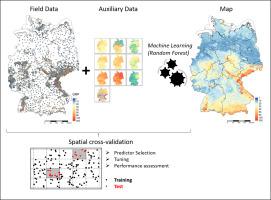Science of the Total Environment ( IF 8.2 ) Pub Date : 2020-09-14 , DOI: 10.1016/j.scitotenv.2020.142291 Eric Petermann , Hanna Meyer , Madlene Nussbaum , Peter Bossew

|
The radioactive gas radon (Rn) is considered as an indoor air pollutant due to its detrimental effects on human health. In fact, exposure to Rn belongs to the most important causes for lung cancer after tobacco smoking. The dominant source of indoor Rn is the ground beneath the house. The geogenic Rn potential (GRP) - a function of soil gas Rn concentration and soil gas permeability - quantifies what “earth delivers in terms of Rn” and represents a hazard indicator for elevated indoor Rn concentration. In this study, we aim at developing an improved spatial continuous map of Rn concentrations based on 4448 field measurements of GRP distributed across Germany. We fitted three different machine learning algorithms, multivariate adaptive regression splines, random forest and support vector machines utilizing 36 candidate predictors. Predictor selection, hyperparameter tuning and performance assessment were conducted using a spatial cross-validation where the data was iteratively left out by spatial blocks of 40 km*40 km. This procedure counteracts the effect of spatial auto-correlation in predictor and response data and minimizes dependence of training and test data. The spatial cross-validated performance statistics revealed that random forest provided the most accurate predictions. The predictors selected as informative reflect geology, climate (temperature, precipitation and soil moisture), soil hydraulic, soil physical (field capacity, coarse fraction) and soil chemical properties (potassium and nitrogen concentration). Model interpretation techniques such as predictor importance as well as partial and spatial dependence plots confirmed the hypothesized dominant effect of geology on GRP, but also revealed significant contributions of the other predictors. Partial and spatial dependence plots gave further valuable insight into the quantitative predictor-response relationship and its spatial distribution. A comparison with a previous version of the German GRP map using 1359 independent test data indicates a significantly better performance of the random forest based map.
中文翻译:

通过机器学习绘制德国的地质genic气潜力
放射性gas气(Rn)由于其对人体健康的有害影响而被视为室内空气污染物。实际上,接触Rn是吸烟后肺癌的最重要原因。室内Rn的主要来源是房屋下方的地面。地质Rn势(GRP)是土壤气体Rn浓度和土壤气体渗透率的函数,它量化了“地球以Rn的形式传递”的内容,并表示室内Rn浓度升高的危险指标。在这项研究中,我们旨在根据在德国分布的4448个GRP现场测量结果,开发出改进的Rn浓度空间连续图。我们使用36个候选预测变量拟合了三种不同的机器学习算法,多元自适应回归样条,随机森林和支持向量机。使用空间交叉验证进行预测变量选择,超参数调整和性能评估,在该交叉验证中,数据被40 km * 40 km的空间块迭代地遗漏。此过程抵消了预测和响应数据中空间自相关的影响,并使训练和测试数据的依赖性最小。空间交叉验证的性能统计数据表明,随机森林提供了最准确的预测。被选择为预测性指标的预测因子反映了地质,气候(温度,降水和土壤湿度),土壤水力,土壤物理性质(田间持水量,粗粒分数)和土壤化学性质(钾和氮浓度)。模型解释技术(如预测变量的重要性以及部分和空间依赖性图)证实了地质学对GRP的假设主导作用,但也揭示了其他预测变量的重要作用。部分和空间依赖性图为定量预测值-响应关系及其空间分布提供了更有价值的见解。与使用1359个独立测试数据的德国GRP地图的先前版本进行比较后,发现基于随机森林的地图的性能要好得多。









































 京公网安备 11010802027423号
京公网安备 11010802027423号